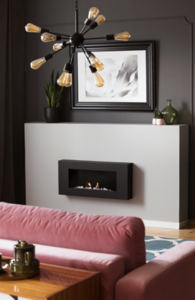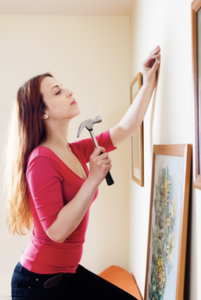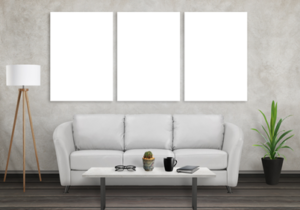
You’ve Got to Have Art
Simple Guidelines to Hanging Art
You’ve acquired new art that brings you joy, now what? Many people get stuck when it comes to putting artwork to, well, work. Some easy “rules” to hang your art can make a room come alive!
Art collector Greg Farrelly, who consults with gallery owners worldwide, said there are just a few basics before you head for the hammer, nail, and leveler.
“You’ll need a measuring tape, and maybe a calculator -if you don’t like simple math,” jokes Farrelly who now lives in Key West and is vice president at Key West Art & Historical Society. Hanging the art properly doesn’t have to be intimidating, he said.
Light-weight pieces without glass can be hung with small nails or even command strips. Medium-weight pieces can be hung with picture-hangers. Heavier pieces need a larger nail, stud-finder or wall-plug anchors, and screws that fit.
How to start:
- For a bare wall, or one without big furniture in front of it. It all starts at the center: To thoroughly enjoy your art, place it at eye level to avoid strain. The art’s focal point should be around 57 inches from the floor. This isn’t where you’ll hang it from, but to determine where you’ll affix the hangers. Measure 57 inches from the floor and mark it on the wall. Then find the focal point of the artwork. To do this, measure the height and divide it in half. For example, a painting that is 30 inches high will have a center of 15. Then measure the top of the artwork to the hanging wire or hook. Subtract this number from the focal point. For example, a hanging wire could be 10 inches from the top of the frame. Subtract 10 inches and you get 5. Take the new number and measure that distance above the 57-inch mark to find where the hanger should be placed (and marked). In our example, this would be 5 inches above the 57-inch mark.

There’s a note to this though: if the room has distinctly high or lower ceilings, or thick decorative molding, you might go a bit higher or lower, to create balance.
- Dealing with furniture or mantles: Obviously, with a sofa, bed, mantle, or other furniture, the 57-inch rule won’t apply to that, either.
- Farrelly recommends having the bottom of the frame at least 6 inches above the top of the furniture or mantle. It’s OK to go above 57 inches if need be.
- Multiple Pieces: Here’s the trick! When hanging several pieces of art, treat the collection as one piece. Anchoring the artwork around the 57-inch focal point achieves balance and the ideal spacing is between 3 and 6 inches.

Lighting is Important
- Light can be harmful: It isn’t just a matter of throwing a floodlight on your Karyna Puhachova.
 Light can degrade and discolor the artwork. Avoid displaying artwork in bright sunlight. Don’t let light directly face the art and avoid fluorescent lighting (it emits high ultraviolet energy that speeds up color fading).
Light can degrade and discolor the artwork. Avoid displaying artwork in bright sunlight. Don’t let light directly face the art and avoid fluorescent lighting (it emits high ultraviolet energy that speeds up color fading). - Different types of lighting: LEDs have a long lifespan and emanate little ultraviolet radiation and heat. They come in warm and cool colors. Halogen lights show off a cooler tone, but generate more heat. Incandescent may give a warm glow, but they give off too much warm light and are inefficient, compared to preferred LEDs.
- Angle it: Farrelly says optimal lighting for artwork should be angled at 30 degrees. This reduces glare and covers the work in decent light. To avoid shadows with larger work, add five degrees. For textured paintings (e.g., oil paintings), subtract 5 degrees.
Other tips include
- If you are hanging family or travel photos, group them tightly together.
- If hanging varying sizes of art together, you can get clean lines by hanging in two rows such as the tops of the frames at 59 inches from the floor in one. The bottom of frames at the row above at 61 inches. Those two inches of space between rows create a clean look.
- If you have one big piece above a sofa or console, the piece should be approximately 2/3 width of the furniture.
- Today for many pieces, you can hang art without damaging your walls. If you are renting, always make sure you have permission to nail into the walls!

As far as how to style? We’ll save that for another blogpost, but the first rule is choose what you love! At the end of the process, beauty is still in the eye of the beholder.